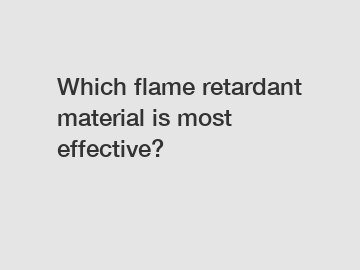Which flame retardant material is most effective?
Intro:
When it comes to fire safety, ensuring the use of effective flame retardant materials is crucial. Fires can have catastrophic consequences, causing loss of life, property damage, and environmental devastation. With various options available, finding the most effective flame retardant material can be challenging. In this blog, we will explore some popular flame retardant materials and determine which one reigns supreme.
1. Understanding Flame Retardant Materials:

Flame retardant materials are designed to slow down or prevent the spread of fire. These materials work by inhibiting ignition, reducing the heat released, or delaying the combustion process. Different flame retardant materials employ diverse mechanisms to achieve fire resistance. Let's take a closer look at three commonly used options.
2. Halogenated Flame Retardants:
Halogenated flame retardants contain elements such as chlorine or bromine. These compounds release halogen radicals when exposed to heat, effectively interrupting the combustion chain reaction. Halogenated flame retardants demonstrate high effectiveness, extinguishing flames promptly. However, concerns regarding their environmental impact and potential health hazards have raised questions about their long-term sustainability.
3. Phosphorous-Based Flame Retardants:
Phosphorous-based flame retardants are gaining popularity due to their lower environmental impact compared to halogenated alternatives. These materials work by releasing phosphorous radicals when exposed to fire, forming a char layer that acts as a barrier against flame spread. Phosphorous-based retardants exhibit good flame resistance while reducing toxicity concerns. However, the effectiveness of these materials varies depending on the specific application.
4. Intumescent Flame Retardants:
Intumescent flame retardant materials are specifically designed to protect structural elements such as wood or steel. They contain a combination of reactive components that undergo a chemical transformation when exposed to heat or flames, forming a thick and insulating char layer. This barrier shields the underlying material, buying valuable time during emergencies. Intumescent materials are highly effective, reliable, and widely used in construction and engineering applications.
5. Considerations for Choosing the Most Effective Material:
Selecting the most effective flame retardant material depends on several factors, including the nature of the application, environmental considerations, and safety requirements. Each material must undergo rigorous testing to determine its fire resistance, toxicity levels, and overall performance.
6. Innovations in Flame Retardant Materials:
The quest for more effective flame retardant materials is an ongoing process. Scientists and researchers are constantly exploring new options, such as nanomaterials and intumescent coatings, in search of enhanced performance and safety. Nanotechnology holds promise in creating lightweight, flexible, and highly efficient flame retardant solutions that can be applied to various materials.
7. The Importance of Industry Regulations and Standards:
To ensure uniformity and reliability, various international organizations and regulatory bodies have established stringent fire safety standards. These standards dictate the requirements materials must meet to be considered effective and safe for use. Compliance with these standards ensures that flame retardant materials are thoroughly tested and evaluated for their intended purpose.
Conclusion:
Choosing the most effective flame retardant material requires careful consideration of multiple factors, including application, environmental impact, and safety requirements. While halogenated flame retardants have long been the preferred choice due to their immediate effectiveness, the environmental and health concerns surrounding them now necessitate exploring alternative options. Phosphorous-based materials and intumescent coatings offer promising solutions with improved sustainability and performance. Continued advancements in material science will likely yield even more effective flame retardant materials in the future. Ultimately, our collective focus must be on protecting lives and properties through the careful selection and implementation of fire-resistant solutions.
For more fire-resistant fabric, cn88, Fire Resistant Fabrics Industryinformation, please contact us. We will provide professional answers.

Comments
0